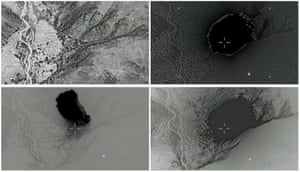
After his evening prayers, Mohammad Shahzadah closed the house gates and sat down for dinner. Then the blast came, engulfing the sky in flames and sending tremors through the ground.
“The earth felt like a boat in a storm,” Shahzadah said. “I thought my house was being bombed. Last year a drone strike targeted a house next to mine, but this time it felt like the heavens were falling. The children and women were very scared.”
The US dropped its largest non-nuclear bomb ever used in combat on eastern Afghanistan on Thursday in another dramatic show of military force by the Trump administration.The GBU-43/B, colloquially known as the “mother of all bombs” or Moab, targeted tunnels and bunkers in Achin district in Nangarhar province, built by fighters loyal to Islamic State who also kept prisoners there.
A GPS-guided demolition bomb with an explosive yield equivalent to 11 tonnes of TNT, it explodes above ground with a radius of more than a mile.
The bomb was dropped in the mountains close to Moman village in an area called Asadkhel. About 1.5 miles away, in Shaddle Bazar where Shahzadah lives, the impact was palpable.
“My ears were deaf for a while. My windows and doors are broken. There are cracks in the walls,” he said.
The US military said it had killed 36 militants. The following morning around 9am, fighter jets strafed the area, a local police commander, Baaz Jan, said.
“We don’t know who was killed yesterday or this morning. But there is confusion and fear in the radio chats we are intercepting. There is limited communication among Isis fighters,” he said.
A local security official said they had requested a large strike because fighter jets and drones had failed to the destroy the tunnel complex.
The top US commander in Afghanistan, General John Nicholson, told reporters in Kabul that the decision to drop the bomb was made in Afghanistan, not in Washington, DC. “Since early March, we’ve been conducting offensive operations into southern Nangarhar,” Nicholson said. “However, this was the first time we encountered an extensive obstacle to our progress.”
Some observers, however, questioned the necessity of deploying a weapon of that scale against a group whose estimated 600 to 800 fighters pose only a limited threat to the Afghan state.
“There is no doubt that Isis are brutal and that they have committed atrocities against our people. But I don’t see why the bomb was dropped,” said the mayor of Achin, Naweed Shinwari. “It terrorised our people. My relatives thought the end of the world had come. Every day fighter jets, helicopters and drones are in the area.”
The US had sustained an air campaign to eradicate Isis in eastern Afghanistan for more than a year, and according to Borhan Osman, an Isis expert with the Afghanistan Analysts Network, it had already been effective.
“Isis was on the brink of losing their stronghold. It didn’t seem like there was a need for such a dramatic military measure,” he said.
Western security reports show that two days of regular airstrikes from 7 to 9 April killed 58 Isis militants.
“The greater threat to the government is the Taliban, but the US is fixated on this minor splinter group because, unlike the Taliban, the Isis group wants to destabilize the region,” said a western diplomat.
He speculated that the US was trying to send a message to countries in the region “that we’re all fighting the same enemy together”, but said the attack could erode US prestige among its allies.
“A basic tenet of international humanitarian law is the principle of distinction. You’re supposed to know what you’re hitting, and it’s not clear that any such targeting is possible with the Moab,” he said.
If the intention was to “shock and awe” Isis fighters and deter recruitment, Osman said he doubted it would be effective.
“Making such big news out of a small organisation, and countering this threat with such a huge measure could indeed make them look more attractive. One of the grounds on which Isis is building its recruitment drive is to say they are fighting the big enemy, the Americans.
“The more it can drive them to the battle, the more successful they are in recruiting anti-western radicals,” he said.
In an attempt to mock the US, an official Isis outlet, Khilafah News, distributed photos on the Telegram messaging app shortly after the bombing of its fighters supposedly continuing daily life in Achin.
The Taliban, who are rivals of Isis, condemned the attack, which the group called an act of “terrorism”.
The Kabul government praised the strike, but Afghanistan’s former president Hamid Karzai denounced it, as did Afghanistan’s envoy to Pakistan, Omar Zakhilwal. It was “reprehensible and counterproductive,” Zakhilwal said on Twitter.
[Source:- Gurdian]



